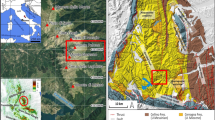Abstract
Our literature studies show that the thermal regime along continental strike-slip rifts is inconspicuous and that they are "low-volcanicity rifts" at best. Along with that, young continental strike-slip rifts exhibit no signs of major thermally controlled doming. We suggest that the larger the strike-slip component of a rift is, the less likely major thermal doming is causally associated with the rift zone. Since vertical lithosphere movements are reflected in the stratigraphic record of a rifted area, different rift modes (strike-slip, dip-slip) may be distinguished by analyzing the relevant sequences. Two ancient and especially suitable strike-slip rift margins in Tethyan mountain belts, the Bangong/Nujiang zone of Tibet and the South Penninic zone of the Alps, were analyzed with regard to their uplift history. The results confirm recent regional rift models which indicate in both cases that rifting was dominated by strike-slip. The stratigraphic approach may provide significant clues as to the mode of paleorifting when structural data are unavailable.
Similar content being viewed by others
Author information
Authors and Affiliations
Additional information
Received: 3 December 1997 / Accepted 21 February 1998
Rights and permissions
About this article
Cite this article
Mattern, F., Schneider, W., Wang, P. et al. Continental strike-slip rifts and their stratigraphic signature: application to the Bangong/Nujiang zone (Tibet) and the South Penninic zone (Alps). Geol Rundsch 87, 206–224 (1998). https://doi.org/10.1007/s005310050203
Issue Date:
DOI: https://doi.org/10.1007/s005310050203




